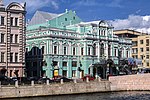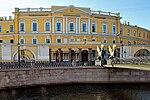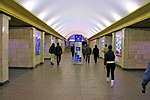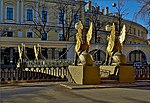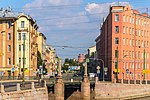Semyonovsky Bridge

Semyonovsky Bridge or Semenovsky Bridge (Russian: Семёновский Мост) is a bridge across the Fontanka River in Saint Petersburg, Russia. It carries the Gorokhovaya Street. It was opened in 1733 as a wooden bridge and became one of the first bridges across Fontanka. The bridge was rebuilt in stone in 1788, presumably, by Jean-Rodolphe Perronet). In 1857 the dilapidated pillars were rebuilt by engineer Fyodor Enrold. Almost a century later, in 1949, the pillars and main beams were reinstalled in metal.The bridge took its name from the Semenovsky Imperial Guard regiment barracks located nearby.The area is home to many sightseeing boats going to the Winter Palace, Peter and Paul Fortress, Summer Garden, and the Church of the Savior on Blood.
Excerpt from the Wikipedia article Semyonovsky Bridge (License: CC BY-SA 3.0, Authors, Images).Semyonovsky Bridge
Семёновский мост, Saint Petersburg
Geographical coordinates (GPS) Address External links Nearby Places Show on map
Geographical coordinates (GPS)
| Latitude | Longitude |
|---|---|
| N 59.9252 ° | E 30.3269 ° |
Address
Семёновский мост
Семёновский мост
191122 Saint Petersburg (Сенной округ)
Saint Petersburg, Russia
Open on Google Maps

